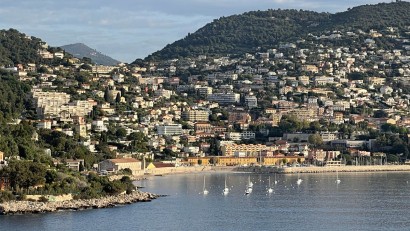- 1. Key Takeaways
- 2. Things to Consider Before Visiting Grand Canyon National Park
- 2.1. Grand Canyon National Park Entrances and Passes
- 2.2. How Many Days Do You Need to Spend in Grand Canyon National Park?
- 2.3. Where to Stay in Grand Canyon National Park
- 2.4. What to Wear When Visiting Grand Canyon National Park
- 3. What to Do and See in Grand Canyon National Park
- 3.1. Grand Canyon Visitor Center Complex
- 3.2. Hunt for the Perfect Viewpoints
- 3.3. Take a Hike
- 3.4. Take a Mule Ride to the River and Back
- 3.5. Raft the Colorado River
- 3.6. Go on a Starry Adventure
- 4. Final Thoughts
- 5. FAQs
- 5.1. Is one day enough for the Grand Canyon?
- 5.2. What is the best month to visit the Grand Canyon?
- 5.3. Is the Grand Canyon free?
- 5.4. Can you tour the Grand Canyon on your own?
- 5.5. What should I be careful of in the Grand Canyon?
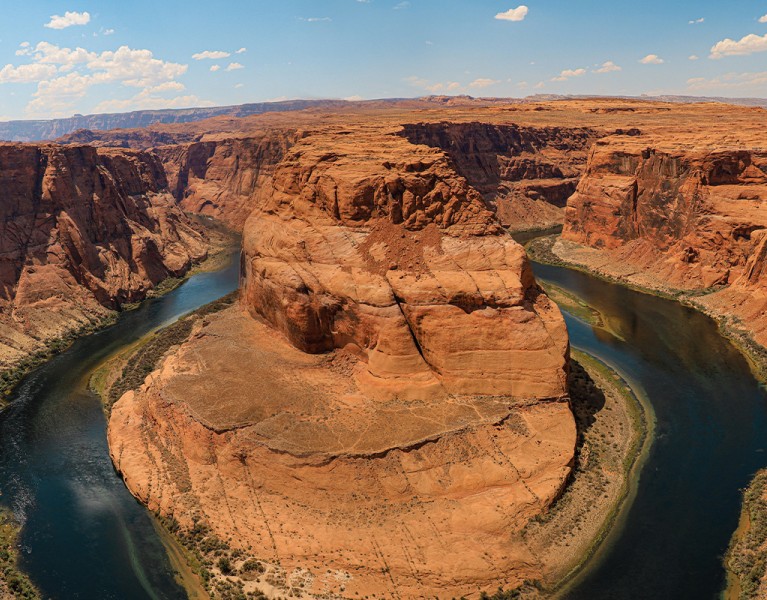
Things to Do in Grand Canyon National Park
Table of Contents [Show]
Experience a new level of awe with a trip to the Grand Canyon. America's grandest national park, this Arizona landmark, receives more than five million visitors annually. Over 40% of these are repeat visitors drawn back by the endless list of things to do in Grand Canyon National Park.
Most new visitors come to get a firsthand look at the Grand Canyon. But soon, they realize that Grand Canyon National Park has much more to offer besides its breathtaking beauty. Rim-to-rim hiking, biking, rafting, camping, and taking mule rides are all possible ways to soak in the grandeur of this beautiful gem.
Go beyond the obligatory Mather Point and Ooh Aah Point with these ideas of unique things to do in Grand Canyon National Park.
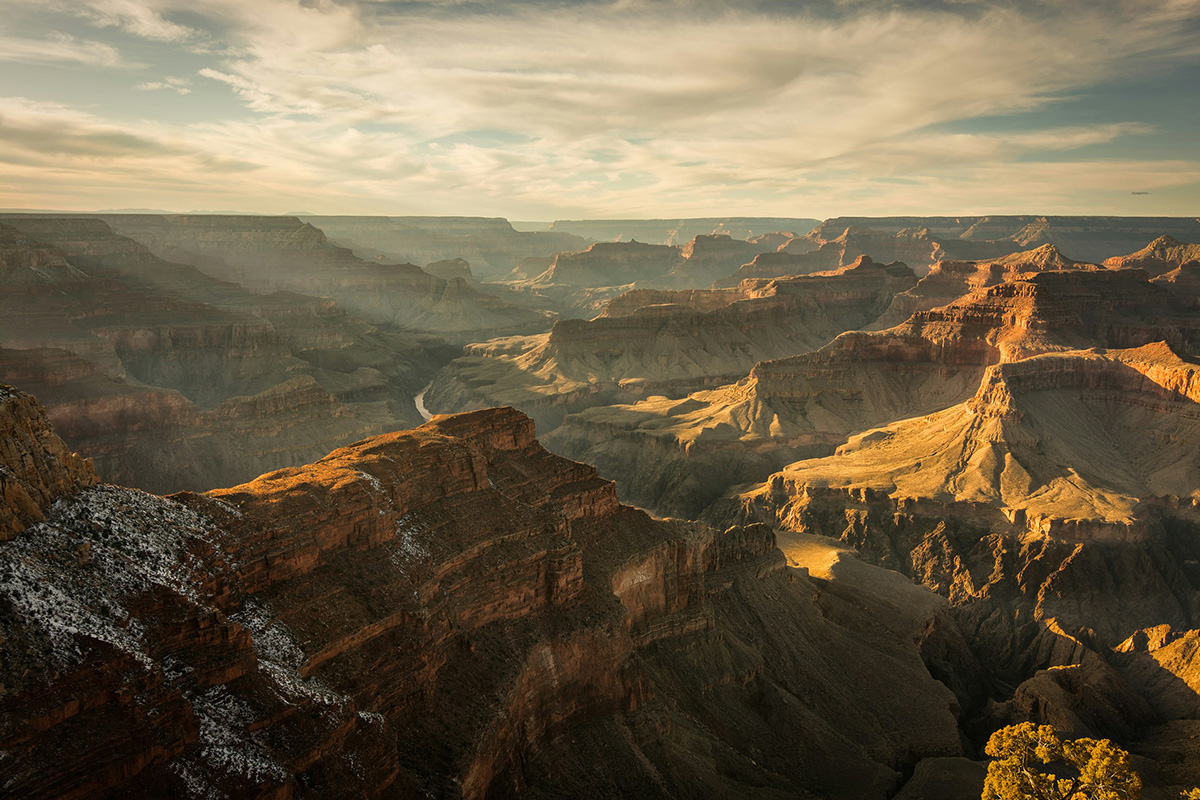
Key Takeaways
- The Grand Canyon's South Rim is the most popular. It's the easiest to access and offers the most attractions and amenities.
- Plan for at least two days for your first visit to the Grand Canyon.
- Grand Canyon National Park has seven lodges, one trailer village, and four established campgrounds.
- Grand Canyon National Park attractions comprise hiking, biking, camping, sightseeing, whitewater rafting, and star gazing.
Things to Consider Before Visiting Grand Canyon National Park
Grand Canyon National Park is in northwestern Arizona, near the Utah and Nevada borders. It is about 3.5 hours from Phoenix, AZ, and 4 hours from Las Vegas, NV. The park's signature attraction is the Grand Canyon, a 277-mile-long, one-mile-deep gorge carved by the Colorado River over millions of years.
In 1908, President Theodore Roosevelt designated the Grand Canyon a national monument. In 1919, President Woodrow Wilson assigned its national park status to protect the natural environment and resources.
Grand Canyon National Park Entrances and Passes
The Grand Canyon is divided into five major parts:
- South Rim
- North Rim
- Havasu Falls
- Grand Canyon West
- Grand Canyon East
Only the South Rim and North Rim are in Grand Canyon National Park. The South Rim is by far the most popular section because it's centrally located for Grand Canyon activities. Plus, it's open year-round and more accessible. It's not a coincidence that the South Rim also boasts more accommodations, tour companies, shops, and restaurants.
There are two entrances to Grand Canyon National Park's South Rim: the South Entrance Station at Tusayan and the East Entrance Station along Desert View Drive.
The North Rim is beautiful in many ways, too. But it's open seasonally from mid-May through mid-October. There is only one entrance to the North Rim of Grand Canyon National Park. It's located 30 miles south of Jacob Lake. Jacob Lake is a beautiful base camp for Grand Canyon visitors along Highway 89A on the Kaibab Plateau.
You don't need a reservation to enter Grand Canyon National Park. An entrance pass is required for all visitors, except during entry fee-free days. Standard entry passes for Grand Canyon National Park cost $20/person, $30 per motorcycle, and $35/vehicle.
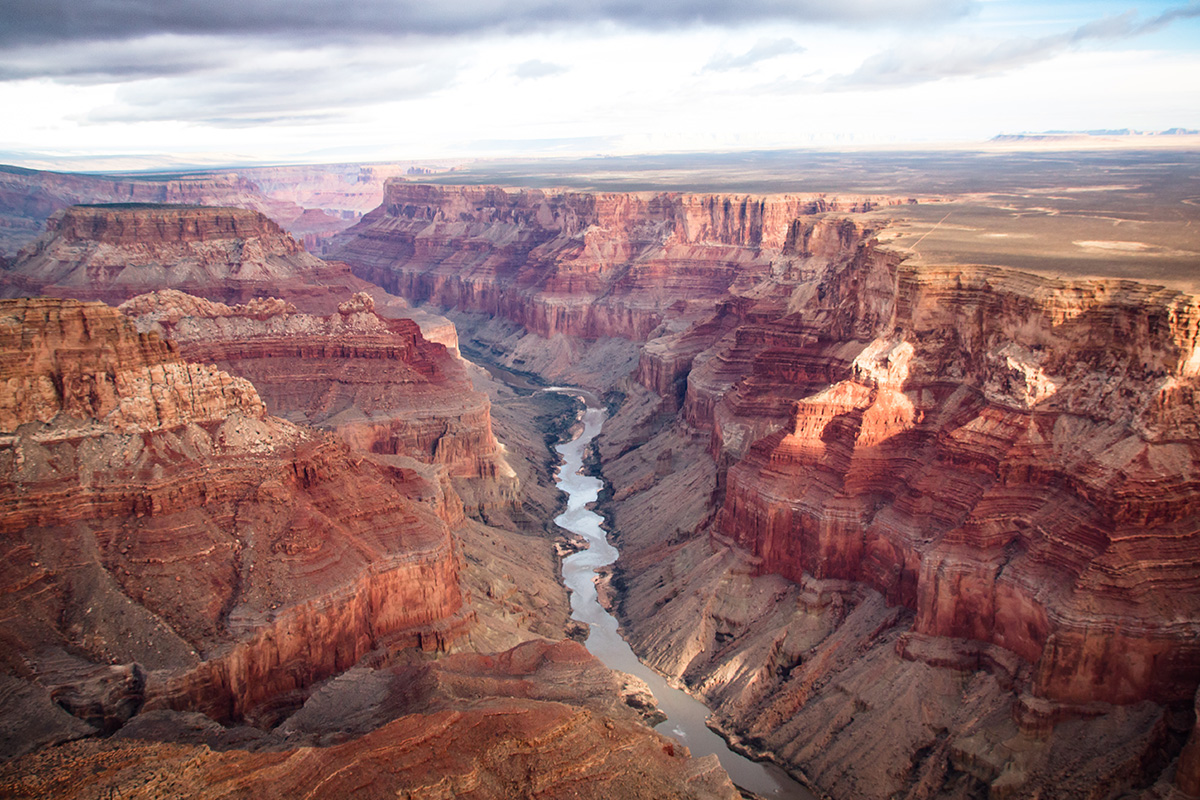
How Many Days Do You Need to Spend in Grand Canyon National Park?
You'll need several days to explore all the things to do at the Grand Canyon. For your first-time visit, we recommend spending at least two days on the South Rim of Grand Canyon National Park or even three if time permits.
Two to three full days in Grand Canyon National Park is enough time to catch a magical sunrise or sunset, attempt an assortment of hikes, and explore several viewpoints along the Rim Trail. Add another day to hike down to the mighty Colorado River or hike rim to rim.
If the Grand Canyon is part of your Arizona road trip and you don't have much time, you can get by with one full day. With one full day in Grand Canyon National Park, you can walk the rim, hike below the rim, drive or ride along Hermit Road, and explore Grand Canyon's intriguing sites like the visitor centers and Yavapai Geology Museum.
Where to Stay in Grand Canyon National Park
Hotels and Lodges within the Park
Grand Canyon National Park South Rim has five hotels and lodges: El Tovar Hotel, Bright Angel Lodge, Kachina & Thunderbird Lodges, Yavapai Lodge, and Maswik Lodge. All of them are located in Grand Canyon Village, steps from the edge of the rim:
From the South Rim, you can also access the famous Phantom Ranch Cabins, the only option for staying at the bottom of the Grand Canyon.
The Grand Canyon Lodge is the only lodge at the North Rim. It features 40 motel-style rooms, 174 cabins, and an on-site restaurant.
All Grand Canyon National Park hotels and lodges are extremely popular and book out fast. Early reservations, up to 13 months in advance, are highly recommended.
All South Rim hotels and lodges are open year-round. The Grand Canyon North Rim Lodge operates during the warmer months, specifically from mid-May to mid-October.
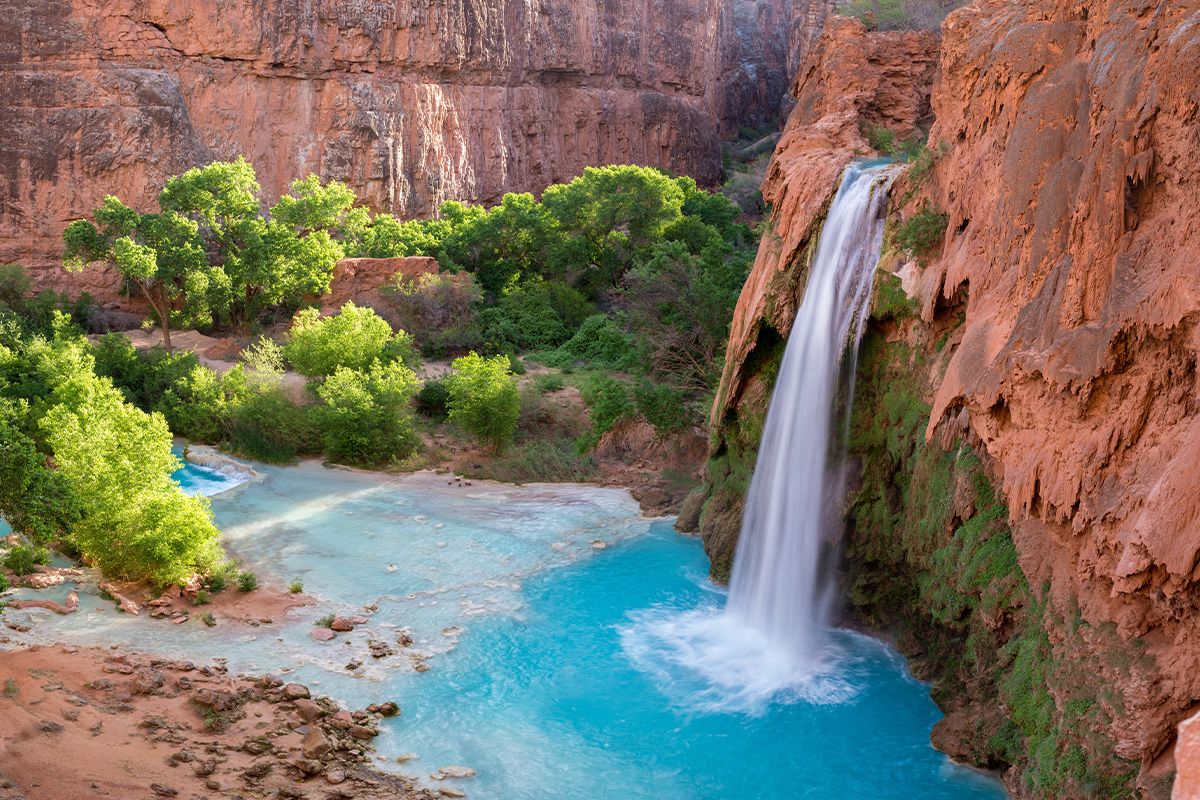
Grand Canyon National Park Camping
Grand Canyon camping is allowed in both developed and backcountry campgrounds. You can camp on the rim, below the rim, or right on the canyon floor.
The best campgrounds on the South Rim of Grand Canyon National Park are:
- Mather Campground
- Desert View
- Trailer Village RV Park
The North Rim of the Grand Canyon has only two campgrounds:
- North Rim Campground
- Tuweep Campground
Kaibab Camper Village is the only RV camping facility with full hookups near the North Rim.
Reservations are required for most Grand Canyon campgrounds and can be made up to six months in advance. Nevertheless, the towns of Tusayan, Williams, Flagstaff, and Jacob Lake have so many camping and glamping options available on a first-come, first-served basis.
Where to Stay Near Grand Canyon National Park
If Grand Canyon National Park hotels, lodges, and campgrounds are fully booked, additional accommodations are available in neighboring towns and communities.
Tusayan, AZ, is the closest town to the South Rim of Grand Canyon National Park. It’s about 20 minutes south of Grand Canyon Village and has a gas station, general store, gift shops, and a few restaurants.
Williams, AZ, about an hour from the park, is another great place to stay when visiting the Grand Canyon. It’s considered the gateway to the Grand Canyon because this is where the historic Grand Canyon train departs.
Flagstaff, AZ, is another noteworthy consideration. It is 90 minutes from the park, but its big-city status means more amenities and additional things to do near the Grand Canyon.
Kaibab Lodge (about 30 minutes away) is the next best place to stay near the North Rim. After that, you’ll want to consider Jacob Lake, AZ (about 65 minutes away) or Page, AZ, roughly 2.5 hours from the North Rim.
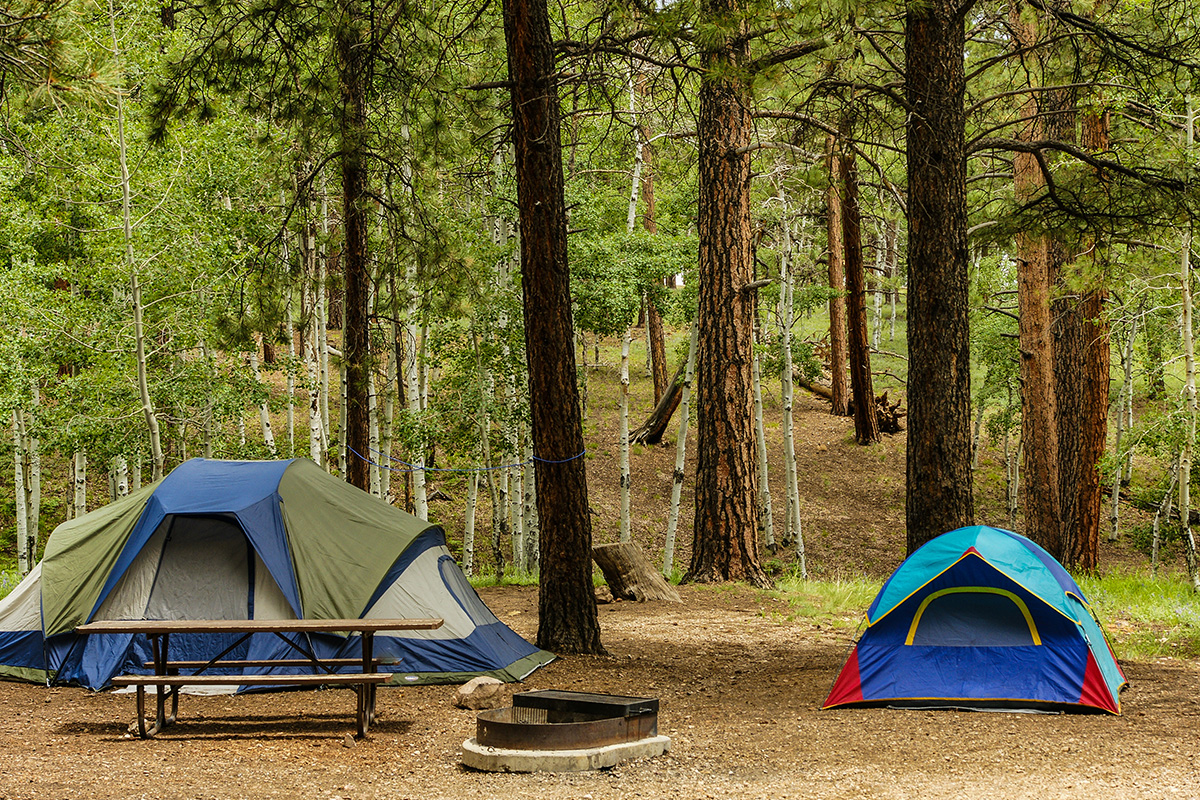
What to Wear When Visiting Grand Canyon National Park
What to wear for the Grand Canyon depends on when you’re visiting and what you plan to do.
Light layers will be your staple if you visit during the summer, as they let you adapt to the park’s weather. Wear a breathable and moisture-wicking tank top or t-shirt and shorts or pants. Add a light jacket or sweater to peel off as the temperature rises.
If you’re camping or staying in an air-conditioned lodge, you’ll want to pack something warmer, like a down jacket and merino wool socks to keep you warm when the temperature drops in the evenings.
Your camping checklist for visiting the Grand Canyon during the winter should include extra warm clothes. It snows in the Grand Canyon, and temperatures can dip to as low as 30ºF.
Other essentials to include in your Grand Canyon backpacking checklist include:
- Rimmed hat
- Sturdy hiking boots
- Sunglasses and sunscreen with 15+ SPF
- Bug spray
- Refillable water bottles
- A high-quality camera
- Trekking poles
- A basic first aid kit (download our first aid checklist)
Comfortable clothing is key to having a positive experience during a Grand Canyon sightseeing trip. Explore various options at Kuhl’s women’s hiking clothing and men’s outdoor wear.
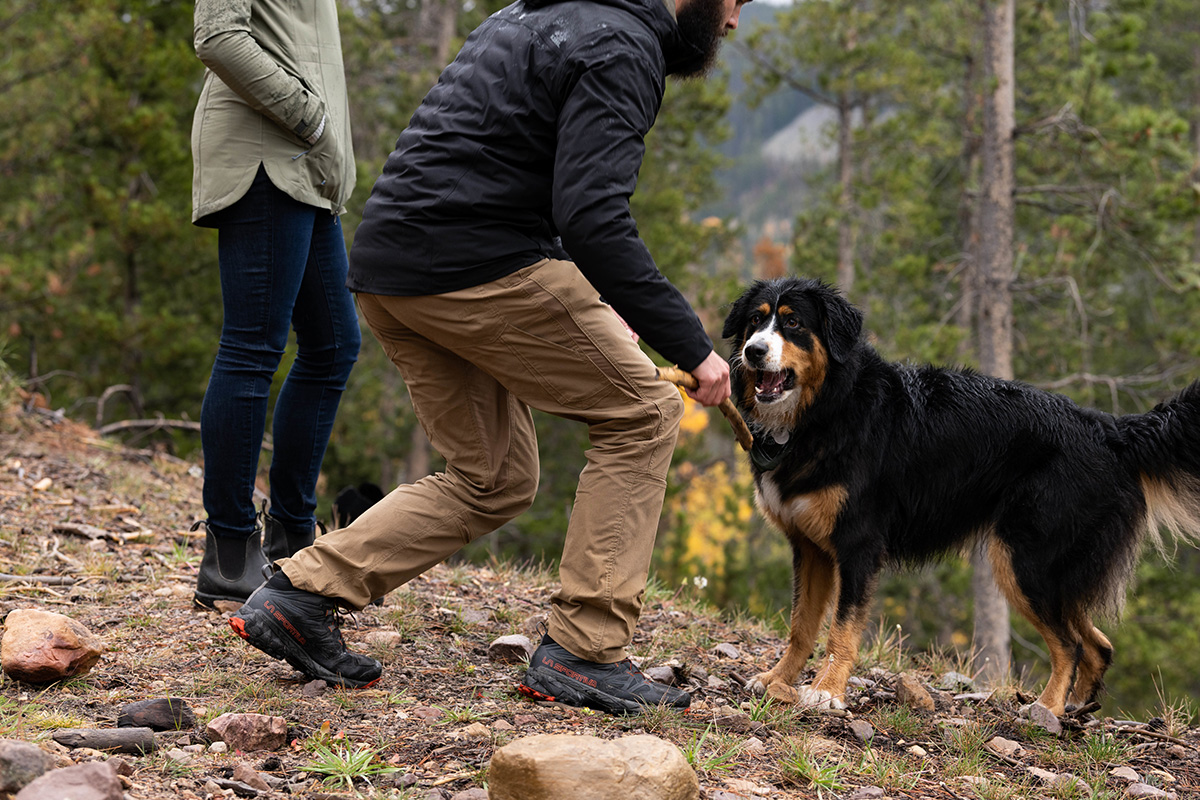
What to Do and See in Grand Canyon National Park
Grand Canyon Visitor Center Complex
Kickstart your list of Grand Canyon National Park things to do with a visit to the National Geographic Visitor Center. An attraction in its own right, the visitor center is a great place to learn about the canyon’s history, geology, and the culture of the communities that live within the park.
The wheelchair-accessible visitor center has many interactive exhibits and an IMAX Theater. These two prepare you for what to expect in the park. You can also use them to plot your self-guided tour.
The complex also includes a cafe serving pizza and sandwiches, a souvenir store, and an electric car charging station. You can purchase your Grand Canyon Entrance Pass here to skip the line at the entrance.
The National Geographic Grand Canyon Visitor Center is located in Tusayan, about five minutes from the South Entrance Station. Entrance tickets to the visitor center start at $14.70 per person.
Hunt for the Perfect Viewpoints
The Grand Canyon is one huge must-see. You’re guaranteed superb views wherever you are along the edge of the gorge. That said, some lookouts afford way better views than others. Here are a few of our favorites:
Near Grand Canyon Village
Mather Point
Mather Point is among the most popular places in Grand Canyon National Park, and this is for good reason. This is the best place to see the Grand Canyon and sections of the Colorado River flowing past Phantom Ranch miles below the rim. The views here stretch 30+ miles to the east and over 60+ miles to the west, making it the perfect spot for landscape photography. Mather Point is a walking distance from the Grand Canyon Visitor Center and a seven-minute drive east of Grand Canyon Village. Arrive early for the best sunrise views and to avoid the crowds.
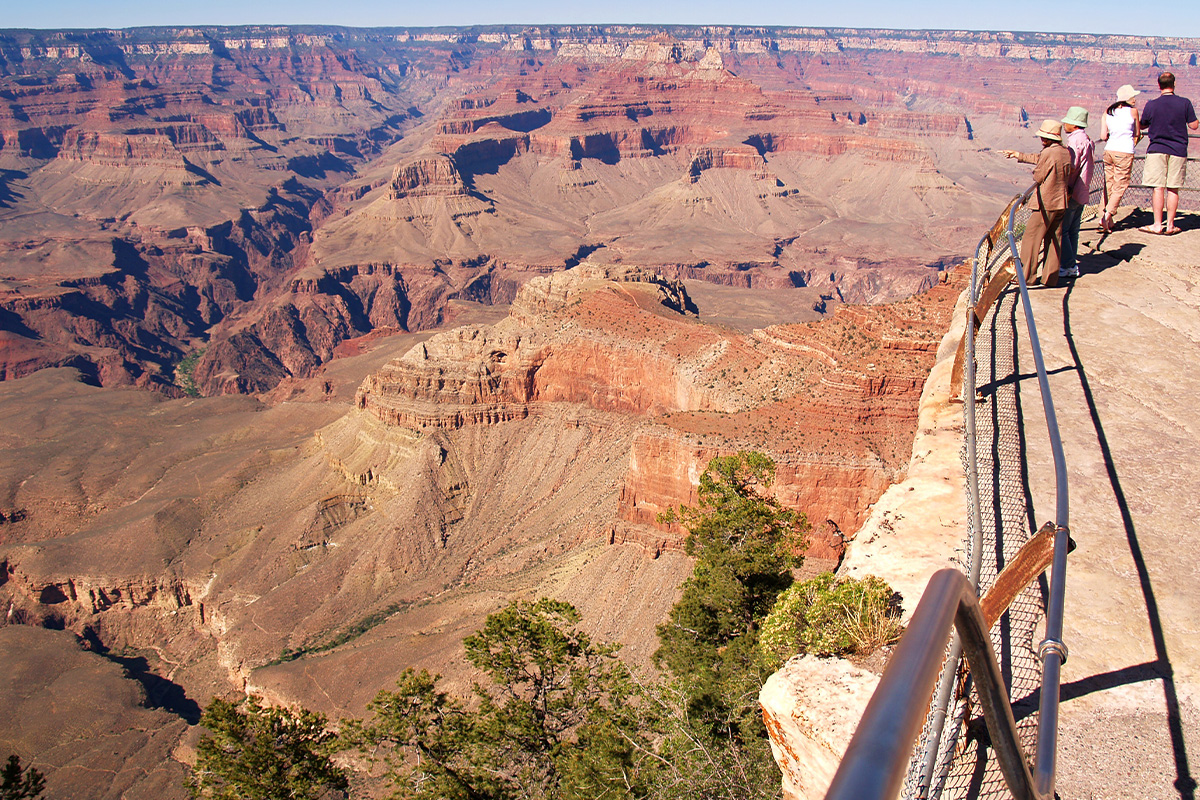
Yavapai Point
If Mather Point is overcrowded, follow the Rim Trail to the west for roughly 20 minutes to Yavapai Point. This is the most northerly observation point in the park, making it the best place to see the Grand Canyon with fewer crowds. The panoramic views here are breathtaking, and there's a geology museum and gift shop nearby.
Yaki Point
As the easternmost overlook on the South Rim, Yaki Point is a Grand Canyon must-see for sunrises and sunsets. Yaki Point offers a unique vantage point from other overlooks because it juts over the canyon. At Yaki Point, enjoy views of the South Kaibab Trail switchbacks and final sections of the Bright Angel Trail. You can also see Cremation Creek to the east and the stunning red rock landscapes on the North Rim. Important to note: Private vehicle access to Yaki Point is prohibited due to congestion. The only way to access this site is via the free Grand Canyon South Rim Shuttle, specifically the Orange Service Route.
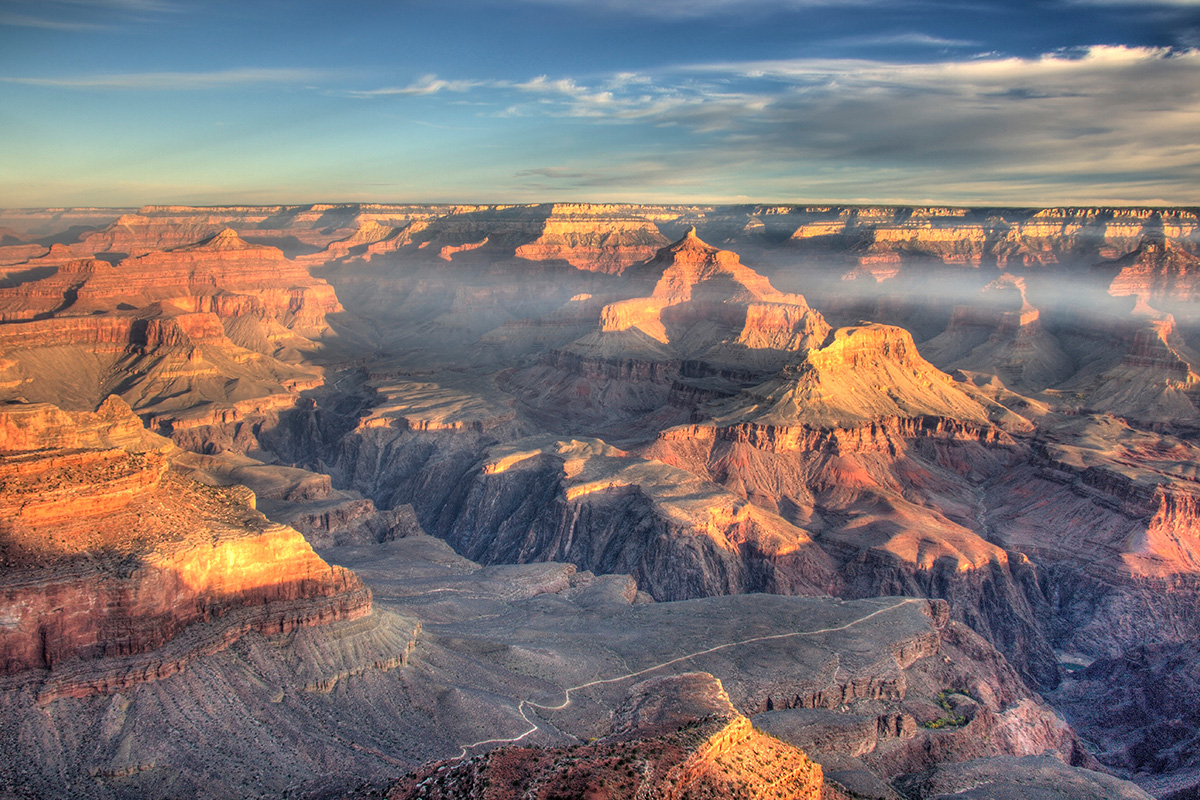
Along Desert View Drive
Consider these vista points if you're approaching or exiting Grand Canyon National Park via the East Entrance Station along Desert View Drive:
Navajo Point
Navajo Point is a mile west of the East Entrance and the Desert View Watchtower. At about 7500 feet, this is the highest natural viewpoint on the South Rim, allowing for unparalleled views of the Grand Canyon. The views from Navajo Point are mainly to the west, stretching as far as Yaki Point (South Rim) and Shiva Temple (North Rim). The Desert View Watchtower is visible to the east. With good eyesight, you should be able to see rafts conquering the infamous Colorado River rapids far below. Considering its easterly location, Navajo Point is one of the best Grand Canyon places to visit for sunrise.
Moran Point
Moran Point is roughly a 10-minute drive to the west of Navajo Point and about 30 minutes east of Grand Canyon Village. This is a popular viewpoint for its gorgeous views of the Grand Canyon's dramatic rock formations and the Colorado River. Moran Point is also a favorite spot for photographers and geology enthusiasts because it offers views of the canyon's geology. Here, you'll come up and close with the three major rock groups of the Grand Canyon: the Grand Canyon Supergroup, Layered Paleozoic Rocks, and the Vishnu Basement Rocks.
Grandview Point
Grandview Point sits almost halfway between Grand Canyon Village and Desert View Watchtower. It's one of the must-see Grand Canyon tourist attractions when heading either way. Its name says it all. This awe-inspiring viewpoint allows spectacular views for miles in all directions, including twists of the river. We'd go there early in the morning or at sunset when the colors and shadows are dramatic. Grandview Point is popular but less crowded than Mather Point.
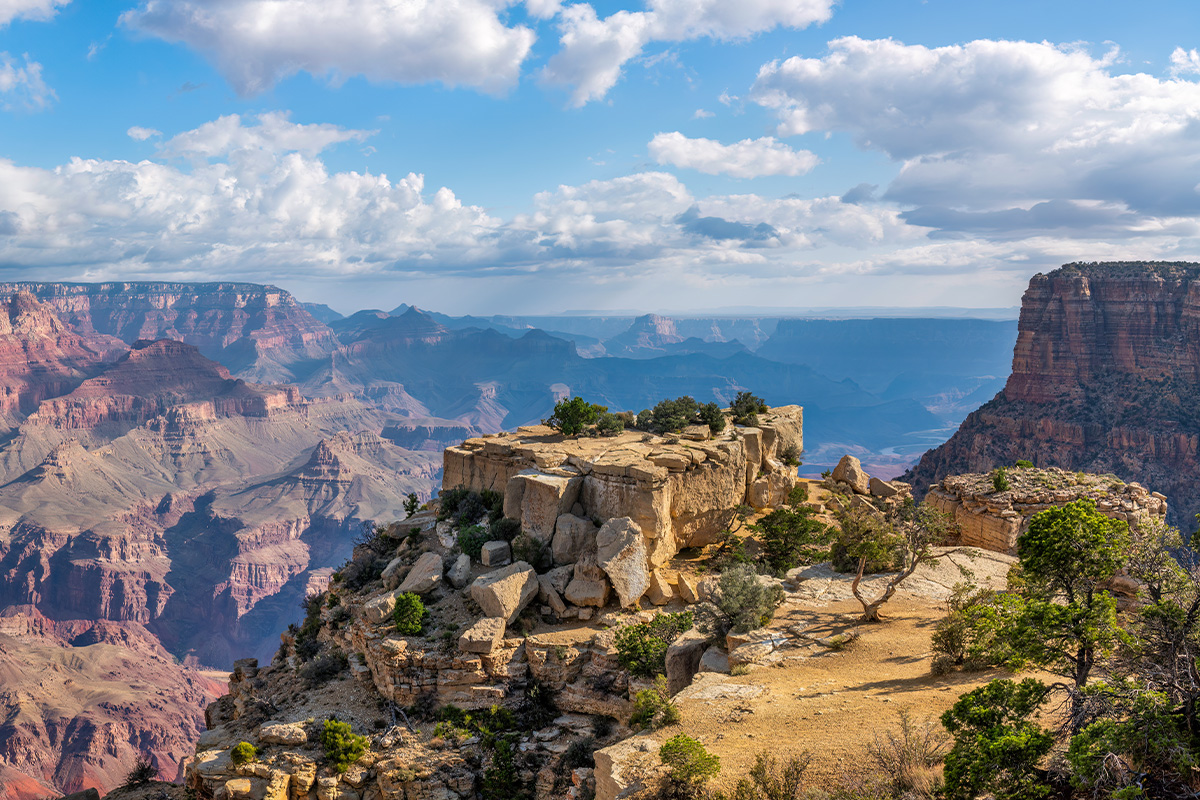
Take a Hike
Most visitors' fondest memories are of hiking in Grand Canyon National Park and the surrounding area. That's because trekking is by far the best way to soak in this region's magnificent scenery.
Grand Canyon National Park has hundreds of hiking trails ranging from easy strolls on the rims to moderate and strenuous hikes down to the Colorado River. You should be able to find several trails suitable for your hiking trails.
If hiking tops your list of what to do at the Grand Canyon, here's a mix of trails you should try:
Rim Trail
Add the Rim Trail to your list if you desire the best easy hikes in Grand Canyon National Park. This is the most popular trail on the South Rim because it's relatively flat, well-maintained, and easy to follow. Plus, your furry friend can accompany you on the trail, provided they are on a leash.
The Rim Trail starts at the Historic Hermits Rest, winding 13 miles east to join the South Kaibab Trailhead. The trail passes Grand Canyon Village and stops at every marked viewpoint along the South Rim. Also, the Rim Trail runs next to the road with 14 shuttle stops along its entire stretch. You can hike part of the trail and hop on the bus when tired. There are 14 shuttle stops spread 0.3 to 1.4 miles from each other along the Rim Trail.
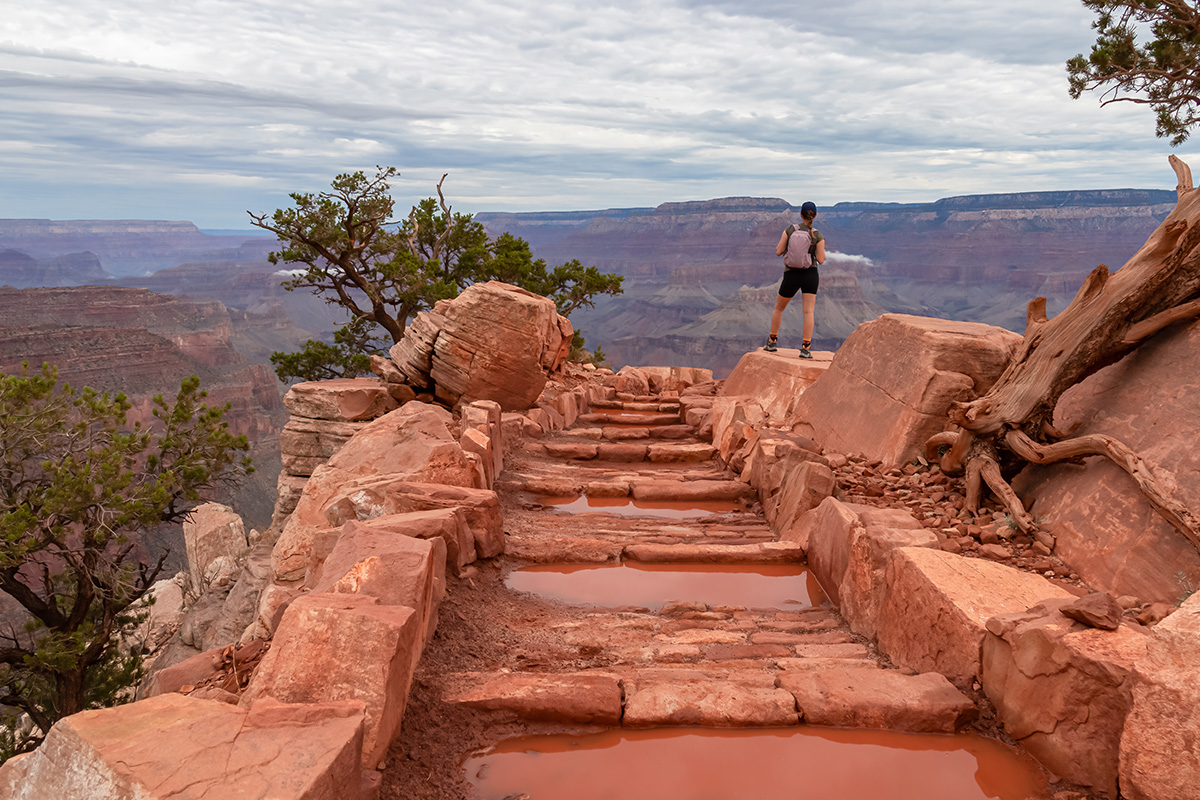
Ooh Aah Point Hike
The hike to Ooh Aah Point is among the best things to do at the Grand Canyon if you want to hike into the canyon but only have a little time. This trek can be done in around two hours. It's a relatively short hike, about 1.8 miles out and back, typically equated to climbing 76 flights of stairs.
This hike is part of the South Kaibab Trail, which goes down to the Colorado River. To get to the trailhead, park your car at the Grand Canyon Visitor Center parking lot and grab the Kaibab Rim (Orange) Route shuttle bus. The bus will stop at Kaibab Trailhead before proceeding to Yaki Point. There is a pre-filtered water filling station and toilets at the trailhead. There's no water on the trail.
South Kaibab Trail
South Kaibab is one of the two major routes that descend to the Colorado River from the South Rim. The trail is a 7.5-mile, steep, and difficult trek that typically takes 4-6 hours one way. However, there are three scenic waypoints where you can stop to rest or turn around to make it a day hike:
- Ooh Aah Point - 1.8 miles roundtrip (2 hours)
- Cedar Ridge - 3 miles roundtrip (2-4 hours)
- Skeleton Point - 6 miles roundtrip (4-6 hours)
Beyond Skeleton Point, you’ve decided to reach the river. This requires spending the night (or a few) at Phantom Ranch or Bright Angel Campground and Lodge before hiking back to the rim. Please don’t try to hike from the rim to the river and back in one day. This route is challenging due to the 5000-foot elevation change and lack of shade.
Note: Visitors need a backcountry permit to stay overnight in the Grand Canyon. Permits are obtained through the Backcountry Information Office. Secondly, the campgrounds and lodges fill up fast. Reserve your accommodation months in advance to avoid frustrations.
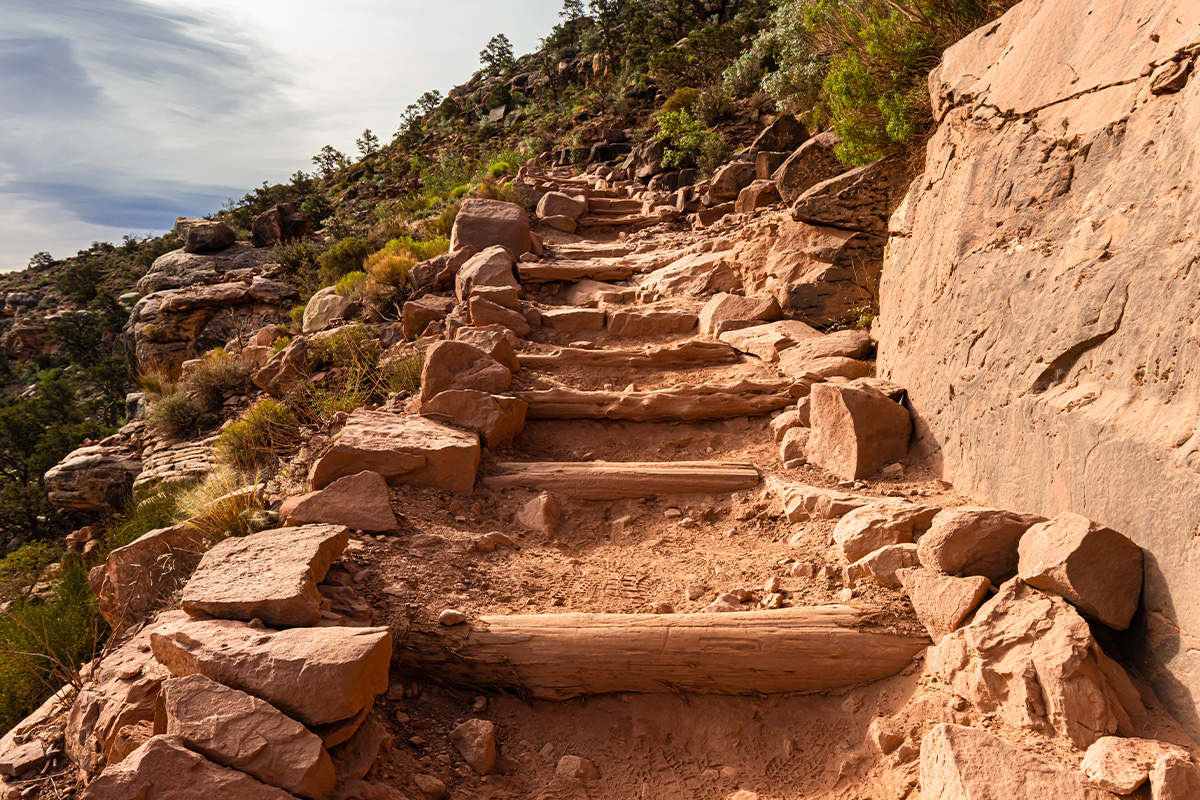
Bright Angel Trail
Bright Angel is the second major “highway” into the Grand Canyon. This is a very popular trail, partly because its trailhead is around the Grand Canyon Village area. Besides the epic views, it also leads to unique places to visit in the Grand Canyon, like Havasupai Garden (formerly Indian Garden) and Garden Creek Waterfall.
The Bright Angel Trail is nine miles long (one way) from the South Rim to Bright Angel Campground. Its elevation gain/loss is 6,840 feet, and most of its waypoints act as water-filling stations.
The Bright Angel Trail is relatively easier than the South Kaibab Trail but also more crowded. Instead of descending to the river and ascending on the same route, most visitors combine the two trails into a 16.5-mile loop hike.
Take a Mule Ride to the River and Back
If you’re looking for the best experiences or memorable things to do in the Grand Canyon, consider riding the sure-footed mule. Mule trips can be the perfect way to descend to the river and back, especially if you don’t have the leg power for the long hikes.
Xanterra Parks and Resorts operates South Rim mule trips. You can book a trip by visiting Xanterra’s website or calling (303) 297-2757. Horseback riding excursions on the North Rim are operated by Canyon Trail Rides. If you don’t have time for a two-day mule ride to the river, Apache Stables near Tusayan offers 1-2-hour mule rides along the South Rim. Mule rides in Grand Canyon National Park range from $60 per person per hour to $2000 per person for multi-day excursions.
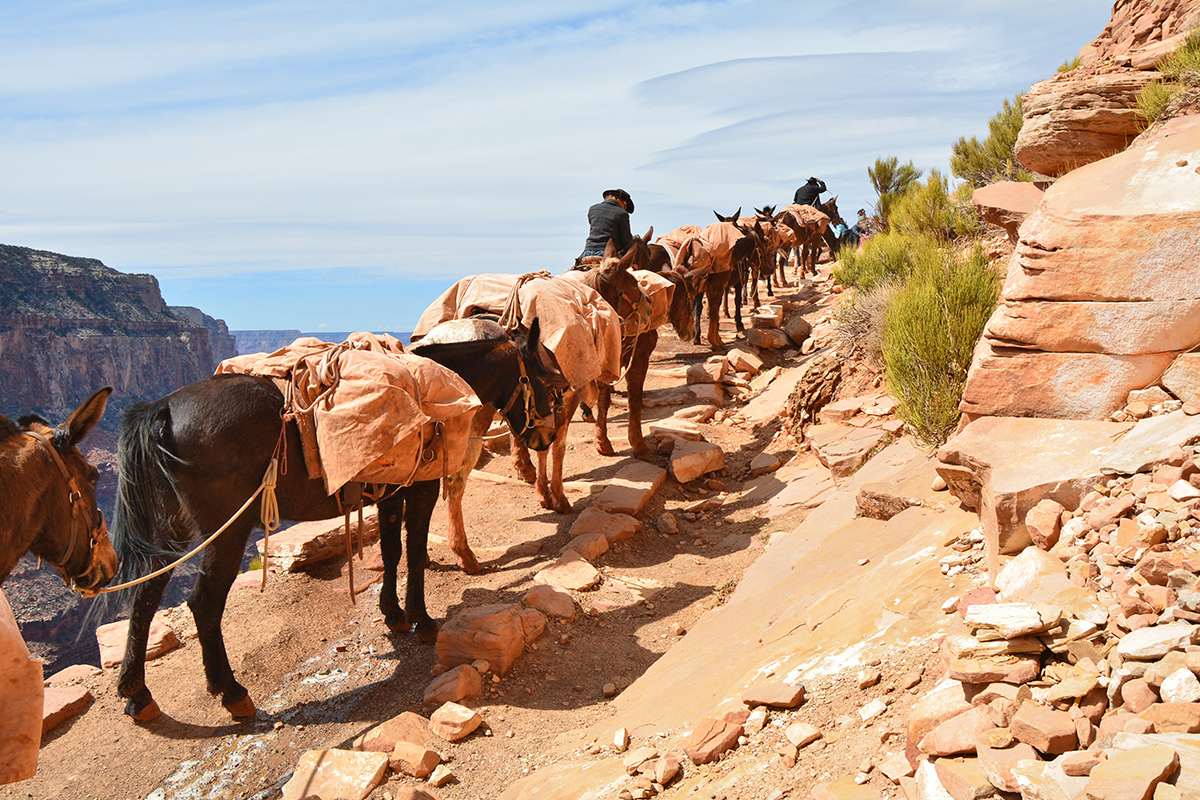
Raft the Colorado River
Nothing compares to viewing the grandeur of the Grand Canyon from below on the Colorado River. With experienced guides, a whitewater rafting trip in the Grand Canyon is a thrilling and life-changing experience. You’ll conquer exciting rapids, explore hidden waterfalls, and learn about the history and geology of the gorge and the Colorado River.
Grand Canyon rafting trips come in all lengths. Choose from half-day to full-day trips or up to 18-day excursions and everything in between. Grand Canyon whitewater rafting costs around $380 for one-day trips.
Go on a Starry Adventure
Exciting things to do around the Grand Canyon don’t end when the sun dips. Grand Canyon National Park is a certified International Dark Sky Park thanks to its remarkably dark skies. For years, visitors from around the world have thronged this natural wonder just to look heavenward and enjoy the views of the Milky Way, constellations, meteor showers, and shooting stars.
Our favorite spots for stargazing in the Grand Canyon South Rim are Desert View and Mather, Yavapai, Moran, and Lipan Points. On the North Rim, hit Cape Royal.
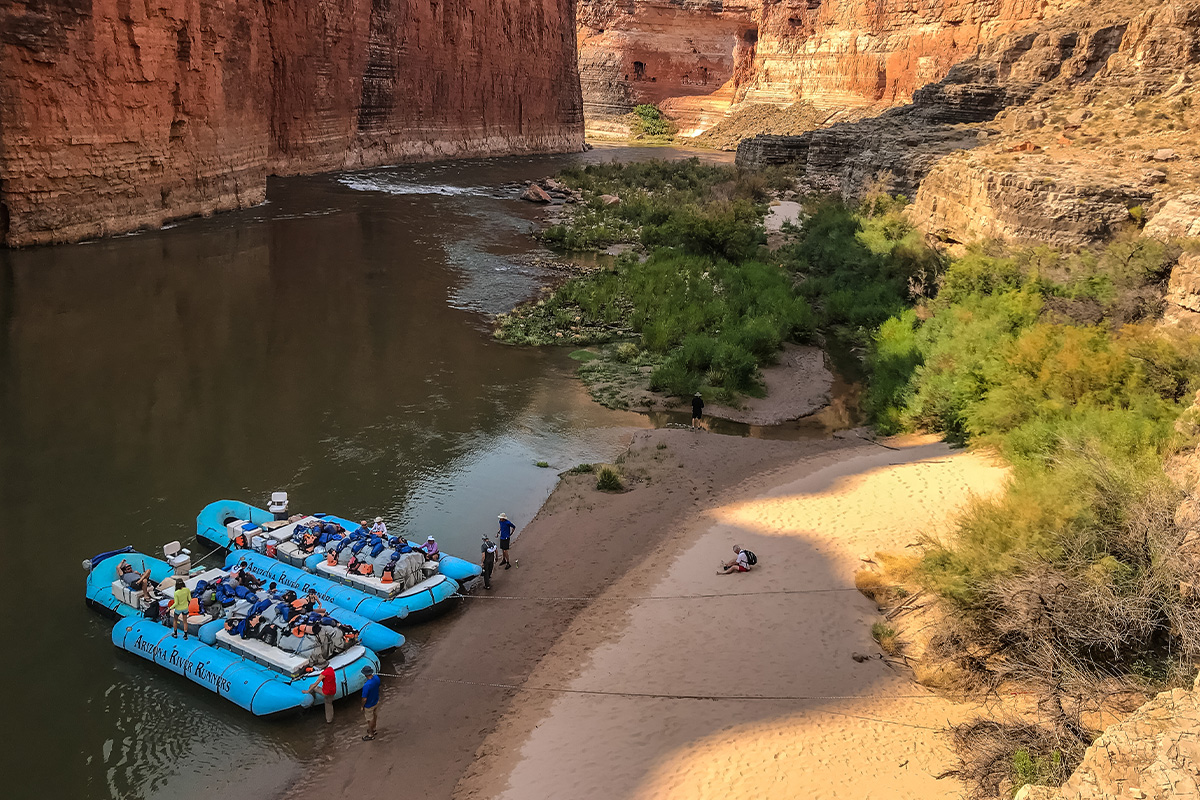
Final Thoughts
That’s an action-packed guide with fun things to do at the Grand Canyon National Park. The Grand Canyon is famous for a good reason. It’s an incredible place that we wholeheartedly recommend every adventure lover to visit at least once in their lifetime. We hope you’ll find this list of the best things to do in the Grand Canyon helpful for planning your visit!
Featured image by: Savannah.
FAQs
Is one day enough for the Grand Canyon?
One day is enough to cover some of the best things to do in the Grand Canyon. With only a day at GCNP, we’d take advantage of the free shuttle service to compare the views of the gorge from various South Rim viewpoints. If time allows, we’d also visit the National Geographic Visitor Center (Tusayan) and Grand Canyon Visitor Center and try a short hike below the rim like Ooh Aah Point.
What is the best month to visit the Grand Canyon?
Spring (March through mid-June) and Fall (late September to late October) are the best times to visit the Grand Canyon. These shoulder seasons afford great weather for hiking, thin crowds, and higher chances of snagging accommodation within the park.
Is the Grand Canyon free?
Grand Canyon National Park has a $20 - $35 admission fee for seven days. However, you can enter the park free of charge during fee-free national park days, usually listed on the NPS website.
Can you tour the Grand Canyon on your own?
Absolutely! Most of the best things to do at Grand Canyon National Park, like hiking, biking, and camping, can be done independently. In fact, you can also bring your mule or horse, so long as it’s sure-footed and trustworthy.
What should I be careful of in the Grand Canyon?
The biggest Grand Canyon dangers are:
- Flash floods - typically common from July to mid-September but can happen anytime rainfall is forecast.
- Dehydration - intense sweating coupled with physical exertion can easily lead to heat stroke. Plan to drink at least half a liter of water per hour of hiking and bring salty snacks to promote hydration.
- Falling over the edge - always stay behind the railings and practice common sense when getting close to unfenced edges.
- Distracted drivers - you may be surprised to learn that serious traffic accidents happen in Grand Canyon National Park due to distractions. Keep an eye on your children and inform them of the danger of stepping into traffic.


